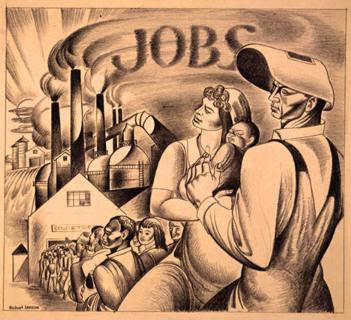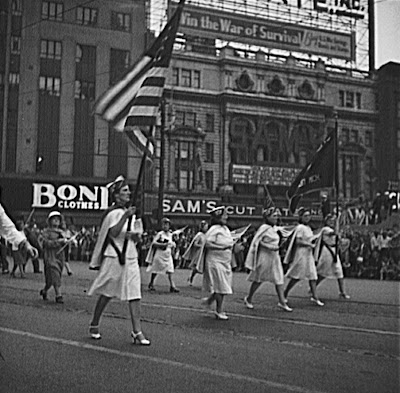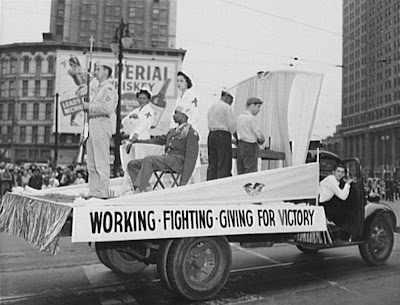.
Norman Rockwell, Rosie the Riviter 1943
The United States Department of Labor tell us that Labor Day, the first Monday in September, is a creation of the labor movement and is dedicated to the social and economic achievements of American workers. It constitutes a yearly national tribute to the contributions workers have made to the strength, prosperity, and well-being of our country.
Founder of Labor Day
More than 100 years after the first Labor Day observance, there is still some doubt as to who first proposed the holiday for workers.
Some records show that Peter J. McGuire, general secretary of the Brotherhood of Carpenters and Joiners and a cofounder of the American Federation of Labor, was first in suggesting a day to honor those "who from rude nature have delved and carved all the grandeur we behold."
But Peter McGuire's place in Labor Day history has not gone unchallenged. Many believe that Matthew Maguire, a machinist, not Peter McGuire, founded the holiday. Recent research seems to support the contention that Matthew Maguire, later the secretary of Local 344 of the International Association of Machinists in Paterson, N.J., proposed the holiday in 1882 while serving as secretary of the Central Labor Union in New York. What is clear is that the Central Labor Union adopted a Labor Day proposal and appointed a committee to plan a demonstration and picnic.
The Moss Industry in the South, Harper's Weekly, September 2, 1882
The First Labor Day
The first Labor Day holiday was celebrated on Tuesday, September 5, 1882, in New York City, in accordance with the plans of the Central Labor Union. The Central Labor Union held its second Labor Day holiday just a year later, on September 5, 1883.
In 1884 the first Monday in September was selected as the holiday, as originally proposed, and the Central Labor Union urged similar organizations in other cities to follow the example of New York and celebrate a "workingmen's holiday" on that date. The idea spread with the growth of labor organizations, and in 1885 Labor Day was celebrated in many industrial centers of the country.
Working Women's Protective Union Hearing Complaint Against Sewing Machine Dealer
Labor Day Legislation
Through the years the nation gave increasing emphasis to Labor Day. The first governmental recognition came through municipal ordinances passed during 1885 and 1886. From them developed the movement to secure state legislation. The first state bill was introduced into the New York legislature, but the first to become law was passed by Oregon on February 21, 1887. During the year four more states — Colorado, Massachusetts, New Jersey, and New York — created the Labor Day holiday by legislative enactment. By the end of the decade Connecticut, Nebraska, and Pennsylvania had followed suit. By 1894, 23 other states had adopted the holiday in honor of workers, and on June 28 of that year, Congress passed an act making the first Monday in September of each year a legal holiday in the District of Columbia and the territories.
A Nationwide Holiday
The form that the observance and celebration of Labor Day should take were outlined in the first proposal of the holiday — a street parade to exhibit to the public "the strength and esprit de corps of the trade and labor organizations" of the community, followed by a festival for the recreation and amusement of the workers and their families. This became the pattern for the celebrations of Labor Day. Speeches by prominent men and women were introduced later, as more emphasis was placed upon the economic and civic significance of the holiday. Still later, by a resolution of the American Federation of Labor convention of 1909, the Sunday preceding Labor Day was adopted as Labor Sunday and dedicated to the spiritual and educational aspects of the labor movement.
Maryland - The Labor Troubles In The Cumberland District - Scenes At and About the Eckhart Mines Detail, Frank Leslie's Illustrated Newspaper, June 10, 1882
Labor Day was important for women who took part in parades and celebrations. It honored women laborers during World War II, who took the place of men in the American workforce, as they were deployed around the world. World War II's Rosie the Riveter was a real woman, Rose Will Monroe, who was born in Pulaski County, Kentucky in 1920, and moved to Michigan during World War II. She worked as a riveter at the Willow Run Aircraft Factory in Ypsilanti, Michigan, building B-29 and B-24 bombers for the U.S. Army Air Forces.
The character of the Labor Day celebration has undergone a change in recent years, especially in large industrial centers where mass displays and huge parades have proved a problem. This change, however, is more a shift in emphasis and medium of expression. Labor Day addresses by leading union officials, industrialists, educators, clerics and government officials are given wide coverage in newspapers, radio, and television.
Pennsylvania - The Carpet-Weaver's Strike in Philadelphia - Female Strikers Patrolling the Streets, Frank Leslie's Illustrated News, November 3, 1888
The vital force of labor added materially to the highest standard of living and the greatest production the world has ever known and has brought us closer to the realization of our traditional ideals of economic and political democracy. It is appropriate, therefore, that the nation pay tribute on Labor Day to the creator of so much of the nation's strength, freedom, and leadership — the American worker.
Labor Day Parade, float of Women's Trade Union League, New York
Women Organizing in the 19th Century compiled by the I Am Woman blog.
1824 Women workers strike for the first time in history at Pawtucket, Rhode Island. 102 women workers strike in support of brother weavers protesting the simultaneous reduction in wages and extension of the workday.
1825 'The United Tailoresses of New York' is formed. It is the first union for women only.
Labor Day
1831 In February of this year, almost 1600 women, all members of the United Tailoresses of New York, strike for "a just price for our labor."
1845 The 'Female Labor Reform Association' is formed in Lowell, Massachusetts by Sarah Bagley and other women cotton mill workers to reduce the work day from 12 or 13 hours a day to 10, and to improve sanitation and safety in the mills where they worked.
Detroit, Michigan. Women workers parading in the Labor Day parade photo by Arthur S. Siegel, September 1942 Photos from Farm Security Administration, Office of War Information Collection, Library of Congress
1853 Antoinette Brown becomes the first U.S. woman to be ordained as a Protestant minister.
1867 Cigar makers are the first national union to accept women and African Americans.
1869 In July, women shoemakers form the 'Daughters of St. Crispin', the first national union of women workers, at Lynn, Massachusetts.
World War II Rosies
1872 Congress passes a law giving women federal employee equal pay for equal work.
1881 In Atlanta, Georgia almost 3,000 black women laundry workers stage one of the largest and most effective strikes in the history of the south.
Detroit, Michigan. Float in the Labor Day parade showing relationship between the Army, Red Cross and industrial workers photo by Arthur S. Siegel, September 1942 Photos from Farm Security Administration, Office of War Information Collection, Library of Congress
1888 Suffragists win passage of a law requiring women doctors for women patients in mental institutions.
1889 Jane Adams founds Hull House in Chicago to assist the poor. It becomes a model for many other settlement houses and establishes social work as a profession for women.
Rosies World War II
1892 Mary Kenney O'Sullivan of the Bindery Workers is appointed the AFL's first female national organizer.
1898 Charlotte Perkins Gillman wrote 'Women and Economics' which argues that women need to be economically independent.
1899 The National Consumers League is formed with Florence Kelley as its president. The League organizes women to use their power as consumers to push for better working conditions and protective law for women workers.
.
Norman Rockwell, Rosie the Riviter 1943
The United States Department of Labor tell us that Labor Day, the first Monday in September, is a creation of the labor movement and is dedicated to the social and economic achievements of American workers. It constitutes a yearly national tribute to the contributions workers have made to the strength, prosperity, and well-being of our country.
Founder of Labor Day
More than 100 years after the first Labor Day observance, there is still some doubt as to who first proposed the holiday for workers.
Some records show that Peter J. McGuire, general secretary of the Brotherhood of Carpenters and Joiners and a cofounder of the American Federation of Labor, was first in suggesting a day to honor those "who from rude nature have delved and carved all the grandeur we behold."
But Peter McGuire's place in Labor Day history has not gone unchallenged. Many believe that Matthew Maguire, a machinist, not Peter McGuire, founded the holiday. Recent research seems to support the contention that Matthew Maguire, later the secretary of Local 344 of the International Association of Machinists in Paterson, N.J., proposed the holiday in 1882 while serving as secretary of the Central Labor Union in New York. What is clear is that the Central Labor Union adopted a Labor Day proposal and appointed a committee to plan a demonstration and picnic.
The Moss Industry in the South, Harper's Weekly, September 2, 1882
The First Labor Day
The first Labor Day holiday was celebrated on Tuesday, September 5, 1882, in New York City, in accordance with the plans of the Central Labor Union. The Central Labor Union held its second Labor Day holiday just a year later, on September 5, 1883.
In 1884 the first Monday in September was selected as the holiday, as originally proposed, and the Central Labor Union urged similar organizations in other cities to follow the example of New York and celebrate a "workingmen's holiday" on that date. The idea spread with the growth of labor organizations, and in 1885 Labor Day was celebrated in many industrial centers of the country.
Working Women's Protective Union Hearing Complaint Against Sewing Machine Dealer
Labor Day Legislation
Through the years the nation gave increasing emphasis to Labor Day. The first governmental recognition came through municipal ordinances passed during 1885 and 1886. From them developed the movement to secure state legislation. The first state bill was introduced into the New York legislature, but the first to become law was passed by Oregon on February 21, 1887. During the year four more states — Colorado, Massachusetts, New Jersey, and New York — created the Labor Day holiday by legislative enactment. By the end of the decade Connecticut, Nebraska, and Pennsylvania had followed suit. By 1894, 23 other states had adopted the holiday in honor of workers, and on June 28 of that year, Congress passed an act making the first Monday in September of each year a legal holiday in the District of Columbia and the territories.
A Nationwide Holiday
The form that the observance and celebration of Labor Day should take were outlined in the first proposal of the holiday — a street parade to exhibit to the public "the strength and esprit de corps of the trade and labor organizations" of the community, followed by a festival for the recreation and amusement of the workers and their families. This became the pattern for the celebrations of Labor Day. Speeches by prominent men and women were introduced later, as more emphasis was placed upon the economic and civic significance of the holiday. Still later, by a resolution of the American Federation of Labor convention of 1909, the Sunday preceding Labor Day was adopted as Labor Sunday and dedicated to the spiritual and educational aspects of the labor movement.
Maryland - The Labor Troubles In The Cumberland District - Scenes At and About the Eckhart Mines Detail, Frank Leslie's Illustrated Newspaper, June 10, 1882
Labor Day was important for women who took part in parades and celebrations. It honored women laborers during World War II, who took the place of men in the American workforce, as they were deployed around the world. World War II's Rosie the Riveter was a real woman, Rose Will Monroe, who was born in Pulaski County, Kentucky in 1920, and moved to Michigan during World War II. She worked as a riveter at the Willow Run Aircraft Factory in Ypsilanti, Michigan, building B-29 and B-24 bombers for the U.S. Army Air Forces.
The character of the Labor Day celebration has undergone a change in recent years, especially in large industrial centers where mass displays and huge parades have proved a problem. This change, however, is more a shift in emphasis and medium of expression. Labor Day addresses by leading union officials, industrialists, educators, clerics and government officials are given wide coverage in newspapers, radio, and television.
Pennsylvania - The Carpet-Weaver's Strike in Philadelphia - Female Strikers Patrolling the Streets, Frank Leslie's Illustrated News, November 3, 1888
The vital force of labor added materially to the highest standard of living and the greatest production the world has ever known and has brought us closer to the realization of our traditional ideals of economic and political democracy. It is appropriate, therefore, that the nation pay tribute on Labor Day to the creator of so much of the nation's strength, freedom, and leadership — the American worker.
Labor Day Parade, float of Women's Trade Union League, New York
Women Organizing in the 19th Century compiled by the I Am Woman blog.
1824 Women workers strike for the first time in history at Pawtucket, Rhode Island. 102 women workers strike in support of brother weavers protesting the simultaneous reduction in wages and extension of the workday.
1825 'The United Tailoresses of New York' is formed. It is the first union for women only.
Labor Day
1831 In February of this year, almost 1600 women, all members of the United Tailoresses of New York, strike for "a just price for our labor."
1845 The 'Female Labor Reform Association' is formed in Lowell, Massachusetts by Sarah Bagley and other women cotton mill workers to reduce the work day from 12 or 13 hours a day to 10, and to improve sanitation and safety in the mills where they worked.
Detroit, Michigan. Women workers parading in the Labor Day parade photo by Arthur S. Siegel, September 1942 Photos from Farm Security Administration, Office of War Information Collection, Library of Congress
1853 Antoinette Brown becomes the first U.S. woman to be ordained as a Protestant minister.
1867 Cigar makers are the first national union to accept women and African Americans.
1869 In July, women shoemakers form the 'Daughters of St. Crispin', the first national union of women workers, at Lynn, Massachusetts.
World War II Rosies
1872 Congress passes a law giving women federal employee equal pay for equal work.
1881 In Atlanta, Georgia almost 3,000 black women laundry workers stage one of the largest and most effective strikes in the history of the south.
Detroit, Michigan. Float in the Labor Day parade showing relationship between the Army, Red Cross and industrial workers photo by Arthur S. Siegel, September 1942 Photos from Farm Security Administration, Office of War Information Collection, Library of Congress
1888 Suffragists win passage of a law requiring women doctors for women patients in mental institutions.
1889 Jane Adams founds Hull House in Chicago to assist the poor. It becomes a model for many other settlement houses and establishes social work as a profession for women.
Rosies World War II
1892 Mary Kenney O'Sullivan of the Bindery Workers is appointed the AFL's first female national organizer.
1898 Charlotte Perkins Gillman wrote 'Women and Economics' which argues that women need to be economically independent.
1899 The National Consumers League is formed with Florence Kelley as its president. The League organizes women to use their power as consumers to push for better working conditions and protective law for women workers.
.














